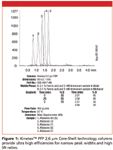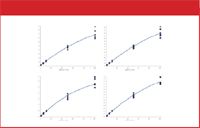Solid-Phase Extraction of Aflatoxins from Peanut Butter and Quantitation Using Kinetex Core-Shell Technology by LC–MS-MS
Due to their high toxicity and carcinogenicity, aflatoxins are of major concern for food producers, the food processing industry, and consumers.
Due to their high toxicity and carcinogenicity, aflatoxins are of major concern for food producers, the food processing industry, and consumers. Most countries have legislation setting maximum permissible limits for aflatoxins, which are in the low micrograms per kilogram for food matrices.
A two-stage SPE procedure using Strata® Florisil® and Strata® Silica is effective in removing detector-interfering contaminants from the difficult sample matrix, peanut butter, while maintaining absolute recoveries above 80%. Samples are analyzed by LC–MS-MS using the new Kinetex™ core-shell particle technology, achieving full resolution of all compounds in less than 2 min with great precision and accuracy.
Experimental Conditions
Extracts of peanut butter were spiked with aflatoxin standards at 50 ppb for LC–MS-MS for use with SPE. Data generated on the API 3000™ LC–MS-MS was done at Phenomenex, Torrance, CA. Work on the API 3200™ Q TRAP® was done at AB/MDS Analytical Technologies in Toronto, Canada. Chromatographic parameters are found in Figure 1.

Figure 1
Results and Discussion
Calibration curves for aflatoxins using the ABI 3200 Q TRAP® were generated from 5 to 500 ppb. To better account for matrix interferences, calibration standards were prepared in a blank peanut butter matrix that had been processed using the Florisil SPE cartridges (Figure 2). Relative recoveries for the aflatoxins obtained using the extracted calibration curve were greater than 90%. (Table I).

Figure 2: Calibration curve from 5â500 ppb for B1, B2, G1, and G2 analytes using a quadratic (1/x) curve fit.
Conclusion
The current work describes a quick and easy method for cleanup and analysis of aflatoxins from peanut butter samples. The two-stage SPE procedure removes a majority of matrix interferences observed in LC–MS-MS chromatography. Combining the high efficiency Kinetex™ core-shell particle with the highly selective PFP chemistry enables ultra fast separation of all four aflatoxins on any LC–MS-MS system configuration. Precision and accuracy of this method were excellent when using a matrix-matched calibration curve. The estimated detection limits for each analyte are well below 5 ppb, which are more than sufficient to allow the method to be used for either confirmation or quantitation.

Table I: QC samples spiked at 50 ppb using quadratic calibration from 5â1000 ppb
Phenomenex is not affiliated with Applied Biosystems.

Phenomenex, Inc.
411 Madrid Ave, Torrance, CA 90501
tel. (310)212-0555, (310)328-7768
Website: www.phenomenex.com


.png&w=3840&q=75)

.png&w=3840&q=75)



.png&w=3840&q=75)



.png&w=3840&q=75)














